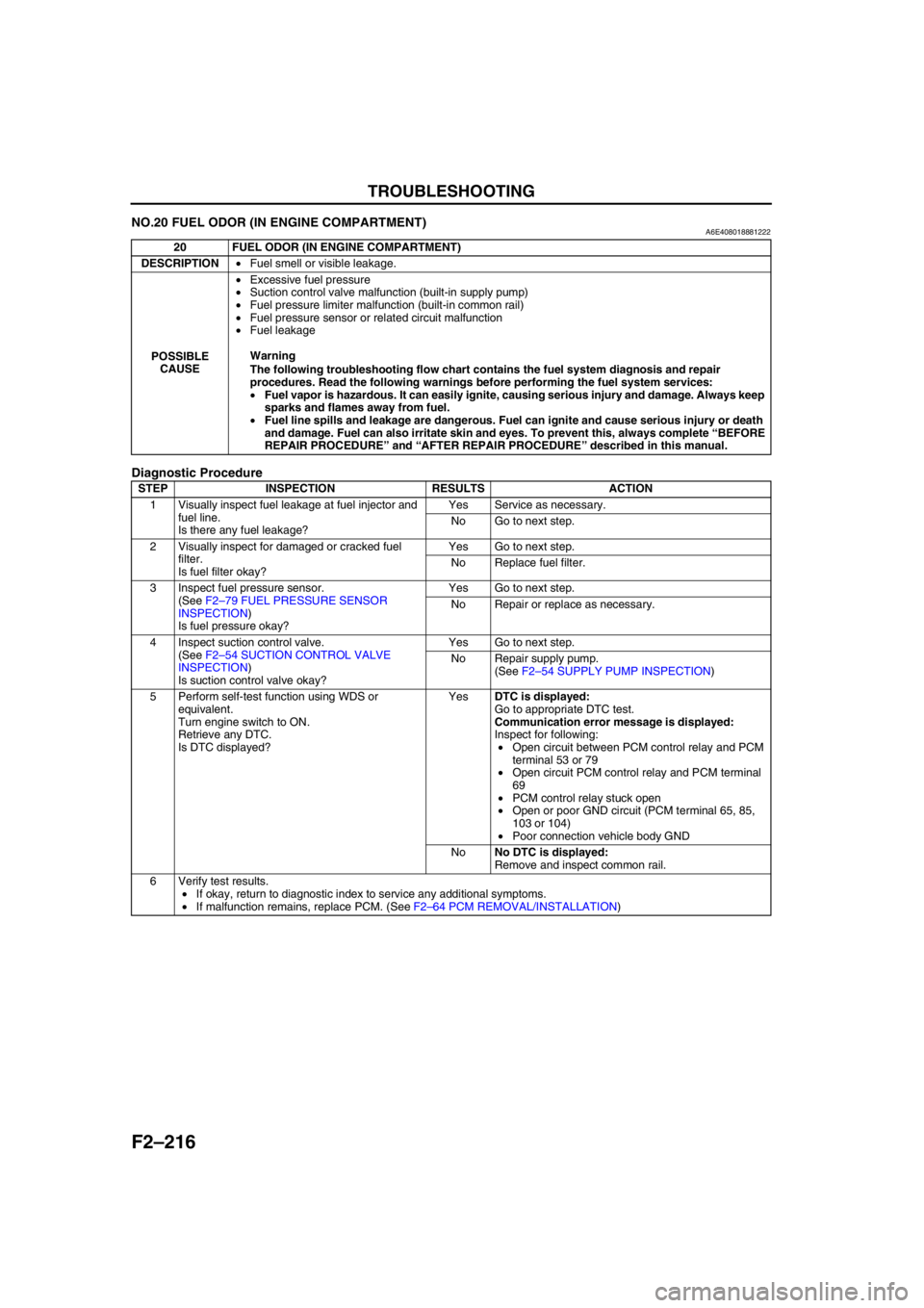fuel MAZDA 6 2002 Workshop Manual Suplement
[x] Cancel search | Manufacturer: MAZDA, Model Year: 2002, Model line: 6, Model: MAZDA 6 2002Pages: 909, PDF Size: 17.16 MB
Page 365 of 909

TROUBLESHOOTING
F2–213
F2
NO.19 EXCESSIVE BLACK SMOKEA6E408018881221
Diagnostic Procedure
19 EXCESSIVE BLACK SMOKE
DESCRIPTION•Excessive black smoke is observed in exhaust gas.
POSSIBLE
CAUSE•Intake-air system clogging or restriction
•Air leakage from Intake-air system
•Incorrect fuel injection timing
•Erratic signal from CKP sensor
•Fuel pressure sensor or related circuit malfunction
•Boost sensor or related circuit malfunction
•IAT sensor No.2 or related circuit malfunction
•Fuel injector malfunction
•Excessive fuel pressure
•Suction control valve malfunction (built-in supply pump)
•Fuel line clogging or restriction
•Fuel pressure limiter malfunction (built-in common rail)
•Low engine compression
•Improper valve timing
•Base engine malfunction
•EGR system malfunction
•Variable boost control (VBC) system malfunction
•Vacuum leakage
•Turbocharger malfunction
•Charge air cooler malfunction
•Intake shutter valve malfunction
•Variable swirl control (VSC) system malfunction
•VSC valve malfunction
•IDM or related circuit malfunction
•Exhaust system and/or catalyst converter restriction or clogging
Warning
The following troubleshooting flow chart contains the fuel system diagnosis and repair
procedures. Read the following warnings before performing the fuel system services:
•Fuel vapor is hazardous. It can easily ignite, causing serious injury and damage. Always keep
sparks and flames away from fuel.
•Fuel line spills and leakage are dangerous. Fuel can ignite and cause serious injury or death
and damage. Fuel can also irritate skin and eyes. To prevent this, always complete “BEFORE
REPAIR PROCEDURE” and “AFTER REPAIR PROCEDURE” described in this manual.
STEP INSPECTION RESULTS ACTION
1 Inspect for following:
•Intake-air system clogging or restriction
•Exhaust system and/or catalyst converter
restriction or clogging
•Charge air cooler condition (restriction or
damaged)
Are all items okay?Yes Go to next step.
No Service as necessary.
Repeat Step 1.
2 Perform self-test function using WDS or
equivalent.
Turn engine switch to ON.
Retrieve any DTC.
Is DTC displayed?YesDTC is displayed:
Go to appropriate DTC test.
Communication error message is displayed:
Inspect for following:
•Open circuit between PCM control relay and PCM
terminal 53 or 79
•Open circuit PCM control relay and PCM terminal
69
•PCM control relay stuck open
•Open or poor GND circuit (PCM terminal 65, 85,
103 or 104)
•Poor connection vehicle body GND
NoNo DTC is displayed:
Go to next step.
3 Does any other symptom exist? Yes Go to appropriate flowchart.
No Go to next step.
4 Inspect for air cleaner element for clogging.
Is air cleaner element okay?Yes Go to next step.
No Repair or replace air cleaner element.
Page 367 of 909

TROUBLESHOOTING
F2–215
F2
End Of Sie
15 Inspect if turbocharger compressor wheel
locknut is loose or has fallen down inside
turbocharger.
Is there any problem?Yes Replace turbocharger.
No Go to next step.
16 Inspect if turbocharger compressor wheel by
hand.
Does wheel turn easily and smoothly?Yes Go to next step.
No Replace turbocharger.
17 Inspect if turbocharger turbine wheel is
damaged, cracked or interfering with housing on
vehicle.
Note
•Inspect all fins on each turbine wheel.
Is there any problem?Yes Replace turbocharger.
No Go to next step.
18 Is any engine oil found inside turbocharger
compressor housing?Yes Wipe oil off of vehicle and install all removed parts in
Step 15. Then, go to next step.
No Turbocharger is okay.
Install all parts removed is Step 15. Then, go to next
step.
19 Inspect suction control valve.
(See F2–54 SUCTION CONTROL VALVE
INSPECTION)
Is suction control valve okay?Yes Go to next step.
No Repair supply pump.
(See F2–54 SUPPLY PUMP INSPECTION)
20 Is engine compression correct?
(See B2–8 COMPRESSION INSPECTION)Yes Go to next step.
No Inspect for following:
•Damaged valve seat
•Worn valve stem and valve guide
•Worn or stuck piston ring
•Worn piston, piston ring or cylinder
•Improper valve timing
Service as necessary.
21 Inspect IDM.
(See F2–84 INJECTOR DRIVER MODULE
(IDM) INSPECTION)
Is IDM okay?Yes Go to next step.
No Repair or replace as necessary.
22 Inspect fuel injector.
(See F2–56 FUEL INJECTOR INSPECTION)
Is fuel injector okay?Yes Inspect following:
•Boost sensor
•Fuel pressure limiter (built-in common rail)
•Fuel pressure sensor
•Fuel return line restriction or clogging
Service as necessary.
No Repair or replace as necessary.
23 Verify test results.
•If okay, return to diagnostic index to service any additional symptoms.
•If malfunction remains, replace PCM. (See F2–64 PCM REMOVAL/INSTALLATION) STEP INSPECTION RESULTS ACTION
Page 368 of 909

F2–216
TROUBLESHOOTING
NO.20 FUEL ODOR (IN ENGINE COMPARTMENT)A6E408018881222
Diagnostic Procedure
End Of Sie
20 FUEL ODOR (IN ENGINE COMPARTMENT)
DESCRIPTION•Fuel smell or visible leakage.
POSSIBLE
CAUSE•Excessive fuel pressure
•Suction control valve malfunction (built-in supply pump)
•Fuel pressure limiter malfunction (built-in common rail)
•Fuel pressure sensor or related circuit malfunction
•Fuel leakage
Warning
The following troubleshooting flow chart contains the fuel system diagnosis and repair
procedures. Read the following warnings before performing the fuel system services:
•Fuel vapor is hazardous. It can easily ignite, causing serious injury and damage. Always keep
sparks and flames away from fuel.
•Fuel line spills and leakage are dangerous. Fuel can ignite and cause serious injury or death
and damage. Fuel can also irritate skin and eyes. To prevent this, always complete “BEFORE
REPAIR PROCEDURE” and “AFTER REPAIR PROCEDURE” described in this manual.
STEP INSPECTION RESULTS ACTION
1 Visually inspect fuel leakage at fuel injector and
fuel line.
Is there any fuel leakage?Yes Service as necessary.
No Go to next step.
2 Visually inspect for damaged or cracked fuel
filter.
Is fuel filter okay?Yes Go to next step.
No Replace fuel filter.
3 Inspect fuel pressure sensor.
(See F2–79 FUEL PRESSURE SENSOR
INSPECTION)
Is fuel pressure okay?Yes Go to next step.
No Repair or replace as necessary.
4 Inspect suction control valve.
(See F2–54 SUCTION CONTROL VALVE
INSPECTION)
Is suction control valve okay?Yes Go to next step.
No Repair supply pump.
(See F2–54 SUPPLY PUMP INSPECTION)
5 Perform self-test function using WDS or
equivalent.
Turn engine switch to ON.
Retrieve any DTC.
Is DTC displayed?YesDTC is displayed:
Go to appropriate DTC test.
Communication error message is displayed:
Inspect for following:
•Open circuit between PCM control relay and PCM
terminal 53 or 79
•Open circuit PCM control relay and PCM terminal
69
•PCM control relay stuck open
•Open or poor GND circuit (PCM terminal 65, 85,
103 or 104)
•Poor connection vehicle body GND
NoNo DTC is displayed:
Remove and inspect common rail.
6 Verify test results.
•If okay, return to diagnostic index to service any additional symptoms.
•If malfunction remains, replace PCM. (See F2–64 PCM REMOVAL/INSTALLATION)
Page 369 of 909

TROUBLESHOOTING
F2–217
F2
NO.21 ENGINE NOISEA6E408018881223
Diagnostic Procedure
21 ENGINE NOISE
DESCRIPTION•Engine noise under hood.
POSSIBLE
CAUSE•Engine internal damage
•Timing belt displacement
•Fuel injector malfunction
•Loose attaching bolts or worn parts
•Improper drive belt tension
•Air leakage from intake-air system
•Incorrect injection timing
•Erratic signal from CKP sensor
•Erratic signal from CMP sensor
•Fuel pressure sensor or related circuit malfunction
•Boost sensor or related circuit malfunction
•Accelerator position sensor or related circuit malfunction
•MAF/IAT sensor or related circuit malfunction
•ECT sensor or related circuit malfunction
•EGR system or malfunction
•IAT sensor No.2 or related circuit malfunction
•Vacuum leakage
•Suction control valve malfunction (built-in supply pump)
•Air leakage from intake-air system
•Air in power steering fluid line
•Turbocharger operating noise
•Solenoid valve operating noise
Warning
The following troubleshooting flow chart contains the fuel system diagnosis and repair
procedures. Read the following warnings before performing the fuel system services:
•Fuel vapor is hazardous. It can easily ignite, causing serious injury and damage. Always keep
sparks and flames away from fuel.
•Fuel line spills and leakage are dangerous. Fuel can ignite and cause serious injury or death
and damage. Fuel can also irritate skin and eyes. To prevent this, always complete “BEFORE
REPAIR PROCEDURE” and “AFTER REPAIR PROCEDURE” described in this manual.
Note
•PCM checks fuel injection amount during a set interval while idling, and automatically corrects it to
maintain engine efficiency. It is normal that engine noise and vibration might be a little louder during
this process.
STEP INSPECTION RESULTS ACTION
1 Is squeal, click or chirp sound present? Yes Inspect engine oil level, solenoid valves installation or
drive belt.
No Go to next step.
2 Is rumble or grind sound present? Yes Inspect drive belt tension or power steering system
fluid level.
If okay, perform power steering fluid line air bleed.
No Go to next step.
3 Is rattle sound present? Yes Inspect location of rattle for loose parts.
No Go to next step.
4 Is hiss sound present? Yes Inspect for vacuum leakage and intake-air system
leakage.
No Go to next step.
5 Is rap or roar sound present? Yes Inspect exhaust system or loose parts.
No Go to next step.
Page 371 of 909

TROUBLESHOOTING
F2–219
F2
End Of Sie
14 Inspect if turbocharger compressor wheel
locknut is loose or has fallen down inside
turbocharger.
Is there any problem?Yes Replace turbocharger.
No Go to next step.
15 Turn turbocharger compressor wheel by hand.
Does wheel turn easily and smoothly?Yes Go to next step.
No Replace turbocharger.
16 Inspect if turbocharger turbine wheel is
damaged, cracked or interfering with housing on
vehicle.
Note
•Inspect all fins on each turbine wheel.
Is there any problem?Yes Replace turbocharger.
No Go to next step.
17 Is any engine oil found inside turbocharger
turbine housing?YesExcessive amount of oil is found:
Replace turbocharger.
Small amount of oil is found:
Wipe oil off of vehicle, then go to next step.
No Go to next step.
18 Is any engine oil found inside turbocharger
compressor housing?Yes Wipe oil off of vehicle, then go to next step.
No Go to next step.
19 Is any exhaust gas leakage found around
location where turbocharger is attached to
exhaust manifold?Yes Remove turbocharger.
Inspect for cracks on center housing inlet surface.
If cracks are found, replace turbocharger.
No Go to next step.
20 Are any center housing and turbine housing
attaching bolts loose?Yes Retighten loose bolts.
If a bolt is found to be missing, attach appropriate new
bolts.
No Turbocharger is okay.
Install all parts removed in Step 13.
Go to next step.
21 Inspect suction control valve.
(See F2–54 SUCTION CONTROL VALVE
INSPECTION)
Is suction control valve okay?Yes Go to next step.
No Repair supply pump.
(See F2–54 SUPPLY PUMP INSPECTION)
22 Inspect fuel injector and fuel injector gasket.
(See F2–56 FUEL INJECTOR INSPECTION)
Is fuel injector okay?Yes Inspect for following:
•Metal flow
•Bent connecting rod
•Damaged valve seat
•Incorrect valve clearance
No Repair or replace as necessary.
23 Verify test results.
•If okay, return to diagnostic index to service any additional symptoms.
•If malfunction remains, replace PCM. (See F2–64 PCM REMOVAL/INSTALLATION) STEP INSPECTION RESULTS ACTION
Page 372 of 909

F2–220
TROUBLESHOOTING
NO.22 VIBRATION CONCERNS (ENGINE)A6E408018881224
Diagnostic Procedure
22 VIBRATION CONCERNS (ENGINE)
DESCRIPTION•Vibration from under hood or driveline.
POSSIBLE
CAUSE•Loose attaching bolts or worn parts
•Cooling fan No.1 or cooling fan No.2 seat are improper
•Engine or transaxle mounts are improperly installed
•Components malfunction such as worn parts
•Erratic signal from CMP sensor
•ECT sensor or related circuit malfunction
•Accelerator position sensor or related circuit malfunction
•MAF/IAT sensor or related circuit malfunction
•Idle switch or related circuit malfunction
•Incorrect adjustment of accelerator position sensor and/or idle switch
•Fuel injector malfunction
•Vacuum leakage
•Improper tension or damaged drive belts
•Improper balance of wheels or tires
•Driveline malfunction
•Suspension malfunction
Warning
The following troubleshooting flow chart contains the fuel system diagnosis and repair
procedures. Read the following warnings before performing the fuel system services:
•Fuel vapor is hazardous. It can easily ignite, causing serious injury and damage. Always keep
sparks and flames away from fuel.
•Fuel line spills and leakage are dangerous. Fuel can ignite and cause serious injury or death
and damage. Fuel can also irritate skin and eyes. To prevent this, always complete “BEFORE
REPAIR PROCEDURE” and “AFTER REPAIR PROCEDURE” described in this manual.
STEP INSPECTION RESULTS ACTION
1 Inspect following components for loose attaching
bolts or worn parts:
•Cooling fan No.1
•Cooling fan No.2
•Cooling fan No.1 and cooling fan No.2 seat
•Drive belt and pulley
•Engine mounts
•Exhaust system
Are all items okay?Yes Go to next step.
No Readjust or retighten engine mount installation
position.
Service as necessary for other parts.
2 Inspect vacuum leakage.
Are vacuum hoses okay?Yes Go to next step.
No Service as necessary.
Repeat Step 2.
Page 373 of 909

TROUBLESHOOTING
F2–221
F2
End Of Sie
3 Connect WDS or equivalent to DLC-2.
Turn engine switch to ON.
Retrieve any DTC.
Is DTC displayed?YesDTC is displayed:
Go to appropriate DTC test.
Communication error message is displayed:
Inspect following:
•Open circuit between PCM control relay and PCM
terminal 53 or 79
•Open circuit PCM control relay and PCM terminal
69
•PCM control relay stuck open
•Open or poor GND circuit (PCM terminal 65, 85,
103 or 104)
•Poor connection vehicle body GND
NoNo DTC is displayed:
Go to next step.
4 Inspect adjustment of accelerator position
sensor and idle switch.
(See F2–72 ACCELERATOR POSITION
SENSOR INSPECTION)
(See F2–70 IDLE SWITCH INSPECTION)
Are accelerator position sensor and idle switch
adjusted correctly?Yes Go to next step.
No Adjust accelerator position sensor and idle switch
correctly.
(See F2–73 ACCELERATOR POSITION SENSOR
ADJUSTMENT)
(See F2–71 IDLE SWITCH ADJUSTMENT)
5 Inspect adjustment of neutral switch.
(See F2–69 NEUTRAL SWITCH INSPECTION)
Is neutral switch adjusted correctly?Yes Go to next step.
No Adjust neutral switch correctly.
6 Visually inspect CMP sensor and teeth of pulse
wheel.
Are CMP sensor and teeth of pulse wheel okay?Yes Inspect following PIDs:
(See F2–65 PCM INSPECTION)
•ECT
•IAT
•MAF
•RPM
If PID value is not as specified, repair or replace
malfunctioning parts.
If PID value is okay, go to next step.
No Replace malfunctioning parts.
7 Inspect fuel injector.
(See F2–56 FUEL INJECTOR INSPECTION)
Is fuel injector okay?Yes Inspect following systems:
•Wheels
•Transaxle and mounts
•Driveline
•Suspension
Service as necessary.
No Repair or replace as necessary.
8 Verify test results.
•If okay, return to diagnostic index to service any additional symptoms.
•If malfunction remains, replace PCM. (See F2–64 PCM REMOVAL/INSTALLATION) STEP INSPECTION RESULTS ACTION
Page 377 of 909

TROUBLESHOOTING
F2–225
F2
NO.26 CONSTANT VOLTAGEA6E408018881228
Diagnostic Procedure
26 CONSTANT VOLTAGE
DESCRIPTION•Incorrect constant voltage.
POSSIBLE
CAUSE•Constant voltage circuit malfunction
•Accelerator positions sensor or related circuit malfunction
•Fuel pressure sensor or related circuit malfunction
•Boost sensor or related circuit malfunction
•ECT sensor GND circuit malfunction
•MAF/IAT sensor GND circuit malfunction
•IAT sensor No.2 GND circuit malfunction
•Fuel temperature sensor GND circuit malfunction
Note
•Accelerator position sensor, fuel pressure sensor and boost sensor use constant voltage.
STEP INSPECTION RESULTS ACTION
1 Disconnect appropriate sensor connectors
(accelerator position sensor, boost sensor and
fuel pressure sensor) where constant voltage
circuits inspection failed.
Turn engine switch to ON position.
Measure voltage between following appropriate
sensor connector terminals:
•Constant voltage terminal and GND terminal.
Is constant voltage above 6.0 V?Yes Repair constant voltage circuit short to power in
harness.
No Go to next step.
2 Is voltage across battery terminals above 10.5
V?Yes Go to next step.
No Inspect charging system.
3 Turn engine switch to OFF.
Leave appropriate sensor connectors
disconnected where constant voltage inspection
failed.
Measure voltage between positive terminal and
GND circuit at appropriate sensor vehicle
harness connector.
Is voltage above 10.5 V and within 1.0 V of
battery voltage?Yes Go to next step.
No Go to Step 8.
4Note
•Purpose of this step is to determine if
WDS or equivalent is communicating with
PCM.
Turn engine switch to ON.
Attempt to access ECT PID.
Can ECT PID be accessed?Yes Go to Step 7.
No Go to next step.
5 Turn engine switch to OFF.
Disconnect accelerator position sensor and
PCM connectors.
Turn engine switch to ON.
Measure voltage between PCM connector
terminals 104 and 53/79.
Is voltage greater than 10.5 V?Yes Go to next step.
No Repair open circuit between PCM terminal 53/79 and
PCM control relay.
6 Leave accelerator position sensor and PCM
connectors disconnected.
Measure resistance between PCM connector
terminals 104 and 90.
Is resistance greater than 10,000 ohms?Yes Inspect sensor connector for constant voltage again.
No Repair constant voltage circuit short to GND.
7 Turn engine switch to OFF.
Leave accelerator position sensor
disconnected.Disconnect PCM connector.
Measure resistance between PCM connector 90
and constant voltage circuit at appropriate
sensor connector.
Is resistance less than 5.0 ohms?Yes Inspect sensor connector for constant voltage again.
No Repair open constant voltage circuit.
Page 378 of 909

F2–226
TROUBLESHOOTING
End Of Sie
8Note
•Purpose of this step is to determine if
WDS or equivalent is communicating with
PCM.
Reconnect appropriate sensor connector.
Turn engine switch to ON.
Attempt to access ECT PID.
Can ECT PID be accessed?Yes Go to next step.
No Go to Step 11.
9 Are DTCs present for two or more sensors
connected to PCM terminal 91?
Sensor connected to PCM terminal 91:
•Accelerator position sensor. (P0122, P0123,
P0222, P0223).
•ECT sensor (P0117, P0118)
•Fuel pressure sensor (P0192, P0193)
•Fuel temperature sensor (P0182, P0183)
•MAF/IAT sensor (P0102, P0103, P0112,
P0113)
•IAT sensor No.2 (P0097, P0098)Yes Go to next step.
No Repair open GND circuit to sensor where constant
voltage circuit inspection failed.
10 Turn engine switch to OFF.
Disconnect WDS or equivalent from DLC-2.
Disconnect PCM connector.
Measure resistance between GND circuit at
appropriate sensor connector and PCM
connector terminal 91.
Is resistance less than 5.0 ohms?Yes Reconnect sensor connector.
Go to appropriate DTC test.
No Repair open GND circuit.
11 Turn engine switch OFF.
Disconnect PCM connector.
Measure resistance between battery negative
terminal and PCM terminals 65, 85, 103 and
104.
Is each resistance less than 5.0 ohms?Yes Go to next step.
No Repair open GND circuit.
12 Turn engine switch to OFF.
Measure resistance between GND circuit at
following sensor connector and GND:
•Accelerator position sensor
•ECT sensor
•BARO sensor
•Fuel pressure sensor
•Fuel temperature sensor
•MAF/IAT sensor
•IAT sensor No.2
Is resistance below 5.0 ohms?Yes GND circuits are okay.
Inspect sensor connector for constant voltage again.
No Inspect for open GND circuit.
13 Turn engine switch to OFF.
Disconnect accelerator position sensor.
Turn engine switch to ON.
Measure voltage between constant voltage
circuit at accelerator position sensor and battery
negative terminal.
Is voltage less than 0.5V?Yes Inspect sensor connector for constant voltage again.
No Repair constant voltage circuit shorted power in
harness.
14 Verify test results.
•If okay, return to diagnostic index to service any additional symptoms.
•If malfunction remains, replace PCM. (See F2–64 PCM REMOVAL/INSTALLATION) STEP INSPECTION RESULTS ACTION
Page 411 of 909

MANUAL TRANSAXLE
J2–9
J2
No.1 Engine Mount Bracket Removal Note
1. Separate the fuel pipe nearby engine hanger.
2. Support the engine using the SST before
removing the No.1 engine mount.
3. Remove the No.1 engine mount.
Manual Transaxle Removal Note
1. Remove the stud of the No.4 engine mount.
2. Loosen the SST (49 E017 5A0)and lean the
engine toward the transaxle.
3. Support the transaxle on a jack.
4. Remove the transaxle mounting bolts.
5. Remove the transaxle.
9 Lower arm (front, rear) ball joint
(See Section R)
10 Damper fork
11 Tie-rod end ball joint
(See N–8 STEERING GEAR AND LINKAGE
(MZR-CD (RF Turbo)) REMOVAL/INSTALLATION)
12 Stabilizer control link
13 Drive shaft (left side)
(SeeSection M)
14 Drive shaft (right side)
(SeeSection M)
15 Joint shaft
(SeeSection M)
16 Flexible pipe
(See F2–57 EXHAUST SYSTEM REMOVAL/
INSTALLATION)17 No.1 engine mount
(See J2–9 No.1 Engine Mount Bracket Removal
Note)
(See J2–11 No.1 Engine Mount Installation Note)
18 Crossmember bracket
19 Crossmember, steering pipe
(See Section R)
20 No.4 engine mount bracket
(See J2–10 No.4 Engine Mount Installation Note)
21 No.4 engine mount rubber
(See J2–10 No.4 Engine Mount Installation Note)
22 Transaxle mounting bolt (lower side)
23 Manual transaxle
(See J2–9 Manual Transaxle Removal Note)
(See J2–10 Manual Transaxle Installation Note)
49 E017 5A0
A6E5212W019
STUD
A6E5212W020
A6E5212W021